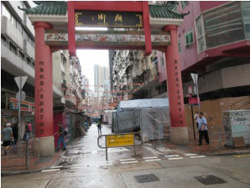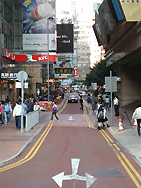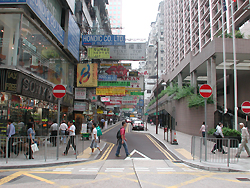
Full-time Pedestrian Street at Paterson Street
1. Introduction
In order to meet the public need for improving the overall pedestrian environment, Transport Department is following an environmentally friendly approach in managing traffic and transport matters and is committed to putting more emphasis on the interests of pedestrians. Since year 2000, Transport Department has been implementing pedestrian schemes in several areas, including Causeway Bay, Central, North Point, Stanley, The Peak, Wan Chai, Mong Kok, Tsim Sha Tsui, Jordan, Sham Shui Po and Shek Wu Hui with the following objectives:
|
2. Types of Pedestrian Schemes
Pedestrian schemes include the following types:
(I) Full-time Pedestrian Street
In full-time pedestrian streets, pedestrians have absolute priority. Vehicular access is restricted to emergency services only but service vehicles may be allowed in specific period, for selected locations.
 Full-time Pedestrian Street at Paterson Street |
(II) Part-time Pedestrian Street
In part-time pedestrian streets, vehicular access is only allowed in specific periods. In order to minimize vehicular access to the area, there is no on-street parking space. However, loading bays are provided for loading and unloading purposes.
 Temple Street |
(III) Traffic Calming Street
In traffic calming streets, footpaths are normally widened and on-street parking spaces are reduced as far as possible. Taxi stands and green minibus stands are only provided if relocation is not practical. There is no restriction to vehicular access. However, vehicles are slowed down through the use of traffic calming measures, such as speed tables, kerb build-outs, sharpened corners, road narrowings, gateways, etc
 Road Narrowing at Hankow Road |
 Speed Table at Russell Street |
 Kerb build-out at Lock Road |
3. Factors considered in developing a pedestrian scheme:
|
Whilst pedestrianisation is desirable from pedestrian and environment standpoint, it is imperative that the design of any pedestrian scheme would not create serious traffic problems on other roads in the vicinity. Otherwise it would only be shifting traffic and environmental problems from one location to another without net gain to the community.
4. Existing and Proposed Pedestrian Schemes
5. We Need Your Help
As drivers :
|
As pedestrians:
|